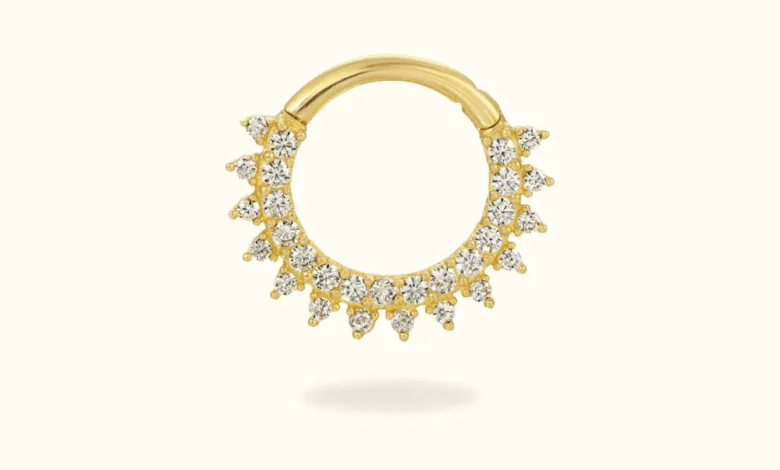
Septum piercings have become increasingly popular, offering a unique and versatile way to express individuality. However, one crucial aspect that often gets overlooked when selecting septum jewelry is the material from which it is made. The material of your septum piercing jewelry can affect not only its appearance but also its comfort, safety, and longevity. This article will delve into various septum piercing jewelry materials, exploring their benefits, potential drawbacks, and suitability for different needs. By the end, you’ll have a clear understanding of which material might be the best fit for you.
Stainless Steel: The Reliable Standard
Overview: Stainless steel is one of the most commonly used materials for body jewelry, including septum piercings. Surgical-grade stainless steel (specifically 316L and 316LVM) is often recommended due to its high biocompatibility and resistance to corrosion.
Benefits:
- Hypoallergenic: Surgical stainless steel is generally safe for most people, minimizing the risk of allergic reactions.
- Durability: It is highly resistant to scratches and dents, making it a long-lasting option.
- Affordability: Stainless steel is relatively inexpensive, offering a budget-friendly option without compromising quality.
- Appearance: The material has a polished, sleek look that complements various styles.
Drawbacks:
- Nickel Content: Although surgical-grade stainless steel has a low nickel content, it might still cause issues for those with severe nickel allergies.
- Weight: Stainless steel is heavier than other materials, which might be uncomfortable for those not used to wearing body jewelry.
Best For: Those looking for a durable, cost-effective, and safe option, particularly if you don’t have a known sensitivity to nickel.
Titanium: The Hypoallergenic Hero
Overview: Titanium is a top choice for those with sensitive skin or allergies. It’s lightweight, strong, and highly resistant to corrosion. The grade most commonly used for body jewelry is ASTM F136, which is implant-grade titanium.
Benefits:
- Completely Hypoallergenic: Titanium is 100% nickel-free, making it the safest option for those with metal sensitivities.
- Lightweight: Titanium is about 40% lighter than stainless steel, offering greater comfort, especially for extended wear.
- Durability: It’s resistant to corrosion, making it a long-lasting material.
- Versatile Appearance: Titanium can be anodized, allowing for various color options without the need for dyes or coatings.
Drawbacks:
- Cost: Titanium tends to be more expensive than stainless steel due to its superior qualities.
- Color Fading: Anodized titanium may lose its color over time, especially with frequent exposure to moisture or friction.
Best For: Individuals with sensitive skin, those with allergies, or anyone looking for a lightweight, durable, and stylish option.
Gold: The Luxurious Choice
Overview: Gold has been a popular material for jewelry for centuries and remains a sought-after option for septum piercings. It’s essential to choose high-quality gold, ideally 14k or 18k, to ensure safety and durability.
Benefits:
- Aesthetic Appeal: Gold offers a timeless, luxurious look that suits both casual and formal styles.
- Biocompatibility: High-quality gold (14k or 18k) is generally safe for most people, minimizing the risk of irritation.
- Durability: Gold is resistant to tarnish and corrosion, especially when alloyed with other metals like copper or silver.
Drawbacks:
- Softness: Pure gold (24k) is too soft for body jewelry and can easily bend or scratch. It’s essential to choose 14k or 18k for a good balance of durability and appearance.
- Cost: Gold is one of the most expensive materials, which may not be feasible for everyone.
- Allergies: Lower karat gold or gold-plated jewelry may contain alloys that can cause allergic reactions.
Best For: Those who prioritize luxury and aesthetics, are willing to invest in high-quality materials, and do not have metal sensitivities.
Niobium: The Unsung Hero
Overview: Niobium is a relatively lesser-known material in the world of body jewelry but is highly respected for its biocompatibility and versatility. Like titanium, niobium can be anodized for various color options.
Benefits:
- Hypoallergenic: Niobium is biocompatible and does not contain nickel, making it safe for most people with allergies.
- Durability: Niobium is strong and resistant to corrosion, similar to titanium.
- Color Versatility: It can be anodized to produce vibrant colors, offering more customization options.
Drawbacks:
- Availability: Niobium is not as widely available as other materials, which might limit your choices.
- Cost: It tends to be more expensive than stainless steel but is generally less costly than titanium or gold.
Best For: Individuals seeking a hypoallergenic material with customizable color options, and those looking for a less mainstream choice.
Bioplast: The Flexible Friend
Overview: Bioplast is a biocompatible, flexible plastic often used for body jewelry. It’s particularly popular for initial piercings due to its gentle nature and ease of wear.
Benefits:
- Hypoallergenic: Bioplast is free from any metals, making it an excellent choice for those with metal sensitivities.
- Flexibility: Its soft, flexible nature makes it comfortable to wear, especially during healing or in situations where rigid materials might cause discomfort.
- Safe for Healing: Bioplast is ideal for new piercings as it reduces irritation and promotes faster healing.
- Affordable: It’s generally less expensive than metal options, making it accessible for those on a budget.
Drawbacks:
- Durability: Being plastic, Bioplast is less durable than metals and may wear down or break over time.
- Limited Aesthetic: While comfortable, Bioplast doesn’t offer the same aesthetic appeal as metals like gold or titanium.
- Not as Elegant: It’s often used as a temporary solution rather than a permanent jewelry choice.
Best For: Those with new piercings, sensitive skin, or those seeking a comfortable, affordable, and hypoallergenic option.
Glass: The Artistic Option
Overview: Glass may not be the first material that comes to mind for septum jewelry, but it offers unique aesthetic qualities. Borosilicate glass, in particular, is popular for its durability and safety.
Benefits:
- Hypoallergenic: Glass is non-reactive and free from allergens, making it suitable for sensitive skin.
- Smooth Surface: The smooth, polished surface of glass reduces the risk of irritation and is comfortable to wear.
- Unique Designs: Glass can be crafted into various shapes, colors, and designs, offering a unique and artistic flair.
- Non-Porous: Glass is non-porous, meaning it won’t harbor bacteria, reducing the risk of infection.
Drawbacks:
- Fragility: Despite its strength, glass can still shatter or crack, especially if dropped or mishandled.
- Weight: Depending on the size, glass jewelry can be heavier than other materials.
- Limited Availability: Glass jewelry, particularly high-quality borosilicate glass, may be harder to find.
Best For: Individuals seeking a hypoallergenic, artistic, and unique jewelry option, and those who are careful with their jewelry.
Acrylic: The Lightweight Contender
Overview: Acrylic is another plastic material used in body jewelry. It’s lightweight, affordable, and available in a wide range of colors and designs.
Benefits:
- Hypoallergenic: Like Bioplast, acrylic is metal-free, reducing the risk of allergic reactions.
- Lightweight: Acrylic is incredibly light, offering comfort even with larger pieces.
- Color Variety: Acrylic comes in many colors and patterns, allowing for a wide range of styles.
- Affordability: It’s one of the most budget-friendly materials available.
Drawbacks:
- Durability: Acrylic is prone to scratches and can crack or break over time.
- Porosity: Acrylic is slightly porous, which means it can harbor bacteria if not cleaned regularly, potentially leading to infection.
- Not Ideal for Healing: Acrylic is generally not recommended for fresh or healing piercings due to its porous nature and potential for causing irritation.
Best For: Those looking for an affordable, lightweight, and colorful jewelry option, particularly for healed piercings.
Silicone: The Stretchable Choice
Overview: Silicone is a flexible, rubber-like material often used in body jewelry. It’s particularly popular for large gauge jewelry and tunnels but can also be found in septum piercing styles.
Benefits:
- Hypoallergenic: Silicone is generally safe for most people, reducing the risk of allergic reactions.
- Comfort: Its soft, flexible nature makes it comfortable for extended wear.
- Easy to Insert and Remove: Silicone’s flexibility makes it easy to insert and remove, which is especially useful for those who change their jewelry frequently.
- Durability: Silicone is resistant to wear and tear, making it a durable option for everyday wear.
Drawbacks:
- Porosity: Silicone can harbor bacteria if not cleaned properly, increasing the risk of infection.
- **Not Ideal for Fresh Pierc
ings**: Silicone is not recommended for new piercings as it can cause irritation and complicate the healing process.
- Limited Aesthetic Options: While comfortable, silicone doesn’t offer the same aesthetic variety as metal or glass jewelry.
Best For: Individuals seeking a comfortable, flexible, and hypoallergenic option, particularly for healed piercings.
Platinum: The Ultimate Luxury
Overview: Platinum is one of the most luxurious materials available for septum jewelry. It’s rare, expensive, and often reserved for high-end, custom-made pieces.
Benefits:
- Hypoallergenic: Platinum is biocompatible and doesn’t contain nickel, making it safe for those with metal sensitivities.
- Durability: It’s highly resistant to wear, tarnish, and corrosion, ensuring that your jewelry remains pristine for years.
- Aesthetic Appeal: Platinum offers a beautiful, shiny appearance that exudes luxury and sophistication.
Drawbacks:
- Cost: Platinum is one of the most expensive materials, which may not be feasible for everyone.
- Weight: It’s heavier than other materials, which might be uncomfortable for some wearers.
Best For: Those who prioritize luxury, durability, and hypoallergenic properties, and are willing to invest in a high-end material.
Silver: The Classic Yet Controversial Choice
Overview: Silver has long been used in jewelry and is known for its bright, shiny appearance. However, it’s essential to exercise caution when using silver for body jewelry, especially in piercings.
Benefits:
- Aesthetic Appeal: Silver offers a classic, polished look that complements various styles.
- Affordability: Silver is generally more affordable than gold or platinum.
- Availability: Silver jewelry is widely available in various designs.
Drawbacks:
- Tarnish: Silver can tarnish over time, especially when exposed to moisture, which can lead to skin irritation.
- Not Ideal for Long-Term Wear: Silver is soft and prone to bending or scratching, making it less durable than other materials.
- Potential Allergic Reactions: Sterling silver, which is 92.5% pure silver, contains other metals like copper, which can cause allergic reactions.
Best For: Those who appreciate the aesthetic appeal of silver and are willing to maintain their jewelry regularly, but it’s better suited for occasional wear rather than long-term use.
Making Your Decision: Factors to Consider
When choosing the right material for your septum piercing jewelry, consider the following factors:
Allergies and Sensitivities: If you have known metal allergies or sensitive skin, opt for hypoallergenic materials like titanium, niobium, or biocompatible plastics.
- Comfort: Consider the weight and flexibility of the material. Lightweight options like titanium or acrylic may be more comfortable for daily wear, while heavier materials like gold or platinum, especially in a septum ring gold, might be better suited for special occasions.
Durability: If you’re looking for a long-lasting option, materials like stainless steel, titanium, or platinum are excellent choices due to their resistance to wear and corrosion.
Aesthetic Preferences: Choose a material that matches your style. Gold, platinum, and silver offer classic, timeless looks, while anodized titanium or glass can provide unique colors and designs.
Budget: Your budget will also play a role in your decision. While gold and platinum offer luxury, they come at a higher cost. Stainless steel and acrylic are more budget-friendly options without sacrificing quality.
- Healing Stage: For fresh piercings, it’s crucial to choose a material that promotes healing, such as titanium, niobium, or Bioplast. Avoid materials like silver or low-quality metals that can cause irritation.
Conclusion
Choosing the right material for your septum piercing jewelry is essential for comfort, safety, and style. Whether you prioritize hypoallergenic properties, durability, aesthetics, or budget, there’s a material out there that suits your needs. By considering your personal preferences and any sensitivities you may have, you can select the perfect septum jewelry that enhances your look and keeps your piercing healthy.


